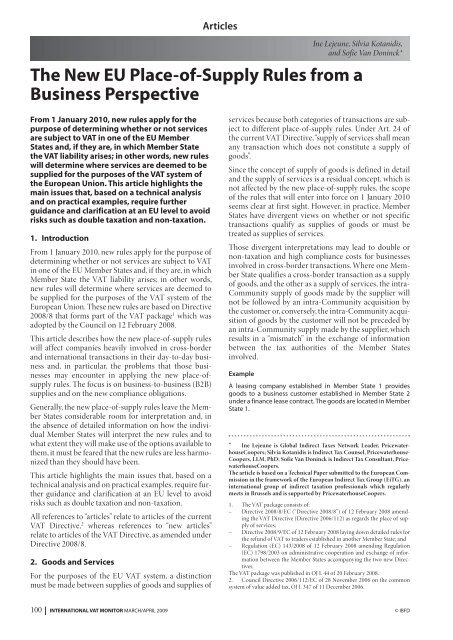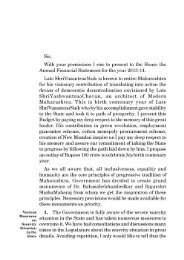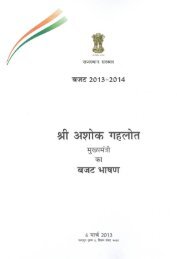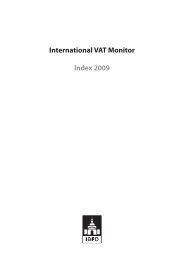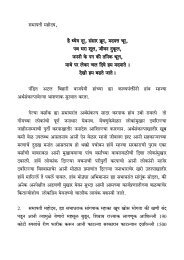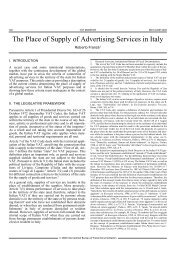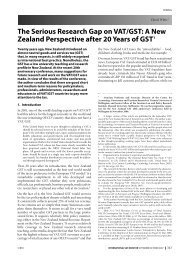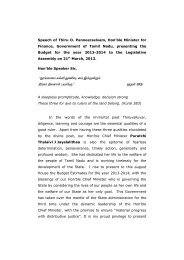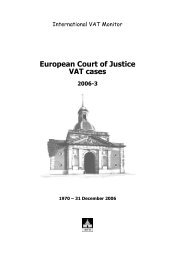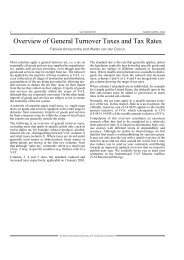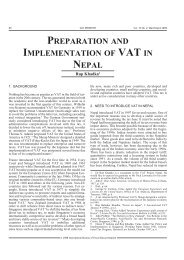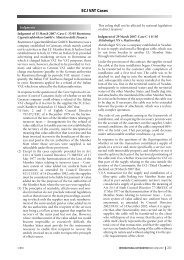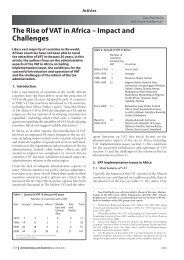The New EU Place-of-Supply Rules from a ... - empcom.gov.in
The New EU Place-of-Supply Rules from a ... - empcom.gov.in
The New EU Place-of-Supply Rules from a ... - empcom.gov.in
You also want an ePaper? Increase the reach of your titles
YUMPU automatically turns print PDFs into web optimized ePapers that Google loves.
From 1 January 2010, new rules apply for the<br />
purpose <strong>of</strong> determ<strong>in</strong><strong>in</strong>g whether or not services<br />
are subject to VAT <strong>in</strong> one <strong>of</strong> the <strong>EU</strong> Member<br />
States and, if they are, <strong>in</strong> which Member State<br />
the VAT liability arises; <strong>in</strong> other words, new rules<br />
will determ<strong>in</strong>e where services are deemed to be<br />
supplied for the purposes <strong>of</strong> the VAT system <strong>of</strong><br />
the European Union. This article highlights the<br />
ma<strong>in</strong> issues that, based on a technical analysis<br />
and on practical examples, require further<br />
guidance and clarification at an <strong>EU</strong> level to avoid<br />
risks such as double taxation and non-taxation.<br />
1. Introduction<br />
From 1 January 2010, new rules apply for the purpose <strong>of</strong><br />
determ<strong>in</strong><strong>in</strong>g whether or not services are subject to VAT<br />
<strong>in</strong> one <strong>of</strong> the <strong>EU</strong> Member States and, if they are, <strong>in</strong> which<br />
Member State the VAT liability arises; <strong>in</strong> other words,<br />
new rules will determ<strong>in</strong>e where services are deemed to<br />
be supplied for the purposes <strong>of</strong> the VAT system <strong>of</strong> the<br />
European Union. <strong>The</strong>se new rules are based on Directive<br />
2008/8 that forms part <strong>of</strong> the VAT package 1 which was<br />
adopted by the Council on 12 February 2008.<br />
This article describes how the new place-<strong>of</strong>-supply rules<br />
will affect companies heavily <strong>in</strong>volved <strong>in</strong> cross-border<br />
and <strong>in</strong>ternational transactions <strong>in</strong> their day-to-day bus<strong>in</strong>ess<br />
and, <strong>in</strong> particular, the problems that those bus<strong>in</strong>esses<br />
may encounter <strong>in</strong> apply<strong>in</strong>g the new place-<strong>of</strong>supply<br />
rules. <strong>The</strong> focus is on bus<strong>in</strong>ess-to-bus<strong>in</strong>ess (B2B)<br />
supplies and on the new compliance obligations.<br />
Generally, the new place-<strong>of</strong>-supply rules leave the Member<br />
States considerable room for <strong>in</strong>terpretation and, <strong>in</strong><br />
the absence <strong>of</strong> detailed <strong>in</strong>formation on how the <strong>in</strong>dividual<br />
Member States will <strong>in</strong>terpret the new rules and to<br />
what extent they will make use <strong>of</strong> the options available to<br />
them, it must be feared that the new rules are less harmonized<br />
than they should have been.<br />
This article highlights the ma<strong>in</strong> issues that, based on a<br />
technical analysis and on practical examples, require further<br />
guidance and clarification at an <strong>EU</strong> level to avoid<br />
risks such as double taxation and non-taxation.<br />
All references to “articles” relate to articles <strong>of</strong> the current<br />
VAT Directive, 2 whereas references to “new articles”<br />
relate to articles <strong>of</strong> the VAT Directive, as amended under<br />
Directive 2008/8.<br />
2. Goods and Services<br />
For the purposes <strong>of</strong> the <strong>EU</strong> VAT system, a dist<strong>in</strong>ction<br />
must be made between supplies <strong>of</strong> goods and supplies <strong>of</strong><br />
Articles<br />
Ine Lejeune, Silvia Kotanidis,<br />
and S<strong>of</strong>ie Van Don<strong>in</strong>ck*<br />
<strong>The</strong> <strong>New</strong> <strong>EU</strong> <strong>Place</strong>-<strong>of</strong>-<strong>Supply</strong> <strong>Rules</strong> <strong>from</strong> a<br />
Bus<strong>in</strong>ess Perspective<br />
services because both categories <strong>of</strong> transactions are subject<br />
to different place-<strong>of</strong>-supply rules. Under Art. 24 <strong>of</strong><br />
the current VAT Directive,“supply <strong>of</strong> services shall mean<br />
any transaction which does not constitute a supply <strong>of</strong><br />
goods”.<br />
S<strong>in</strong>ce the concept <strong>of</strong> supply <strong>of</strong> goods is def<strong>in</strong>ed <strong>in</strong> detail<br />
and the supply <strong>of</strong> services is a residual concept, which is<br />
not affected by the new place-<strong>of</strong>-supply rules, the scope<br />
<strong>of</strong> the rules that will enter <strong>in</strong>to force on 1 January 2010<br />
seems clear at first sight. However, <strong>in</strong> practice, Member<br />
States have divergent views on whether or not specific<br />
transactions qualify as supplies <strong>of</strong> goods or must be<br />
treated as supplies <strong>of</strong> services.<br />
Those divergent <strong>in</strong>terpretations may lead to double or<br />
non-taxation and high compliance costs for bus<strong>in</strong>esses<br />
<strong>in</strong>volved <strong>in</strong> cross-border transactions. Where one Member<br />
State qualifies a cross-border transaction as a supply<br />
<strong>of</strong> goods, and the other as a supply <strong>of</strong> services, the <strong>in</strong>tra-<br />
Community supply <strong>of</strong> goods made by the supplier will<br />
not be followed by an <strong>in</strong>tra-Community acquisition by<br />
the customer or, conversely, the <strong>in</strong>tra-Community acquisition<br />
<strong>of</strong> goods by the customer will not be preceded by<br />
an <strong>in</strong>tra-Community supply made by the supplier, which<br />
results <strong>in</strong> a “mismatch” <strong>in</strong> the exchange <strong>of</strong> <strong>in</strong>formation<br />
between the tax authorities <strong>of</strong> the Member States<br />
<strong>in</strong>volved.<br />
Example<br />
A leas<strong>in</strong>g company established <strong>in</strong> Member State 1 provides<br />
goods to a bus<strong>in</strong>ess customer established <strong>in</strong> Member State 2<br />
under a f<strong>in</strong>ance lease contract. <strong>The</strong> goods are located <strong>in</strong> Member<br />
State 1.<br />
* Ine Lejeune is Global Indirect Taxes Network Leader, PricewaterhouseCoopers;<br />
Silvia Kotanidis is Indirect Tax Counsel, Pricewaterhouse-<br />
Coopers, LLM, PhD; S<strong>of</strong>ie Van Don<strong>in</strong>ck is Indirect Tax Consultant, PricewaterhouseCoopers.<br />
<strong>The</strong> article is based on a Technical Paper submitted to the European Commission<br />
<strong>in</strong> the framework <strong>of</strong> the European Indirect Tax Group (EiTG), an<br />
<strong>in</strong>ternational group <strong>of</strong> <strong>in</strong>direct taxation pr<strong>of</strong>essionals which regularly<br />
meets <strong>in</strong> Brussels and is supported by PricewaterhouseCoopers.<br />
1. <strong>The</strong> VAT package consists <strong>of</strong>:<br />
– Directive 2008/8/EC (“Directive 2008/8”) <strong>of</strong> 12 February 2008 amend<strong>in</strong>g<br />
the VAT Directive (Directive 200 /112) as regards the place <strong>of</strong> supply<br />
<strong>of</strong> services;<br />
– Directive 2008/9/EC <strong>of</strong> 12 February 2008 lay<strong>in</strong>g down detailed rules for<br />
the refund <strong>of</strong> VAT to traders established <strong>in</strong> another Member State; and<br />
– Regulation (EC) 14 /2008 <strong>of</strong> 12 February 2008 amend<strong>in</strong>g Regulation<br />
(EC) 1798/200 on adm<strong>in</strong>istrative cooperation and exchange <strong>of</strong> <strong>in</strong>formation<br />
between the Member States accompany<strong>in</strong>g the two new Directives.<br />
<strong>The</strong> VAT package was published <strong>in</strong> OJ L 44 <strong>of</strong> 20 February 2008.<br />
2. Council Directive 200 /112/EC <strong>of</strong> 28 November 200 on the common<br />
system <strong>of</strong> value added tax, OJ L 47 <strong>of</strong> 11 December 200 .<br />
100 INTERNATIONAL VAT MONITOR MARCH/APRIL 2009 © IBFD
If Member State 1 treats f<strong>in</strong>ance lease as a supply <strong>of</strong> goods,<br />
the supply is deemed to be made at the place where transport <strong>of</strong><br />
the goods beg<strong>in</strong>s or where the goods are located at the time <strong>of</strong><br />
the supply (Member State 1). If Member State 2 treats the transaction<br />
as a supply <strong>of</strong> services, that service is deemed to be supplied<br />
at the place where the customer is established (Member<br />
State 2), which results <strong>in</strong> double taxation.<br />
In the opposite situation, the transaction would not be taxed at<br />
all. Furthermore, the new obligation to also report <strong>in</strong> the recapitulative<br />
statement cross-border services subject to the reverse<br />
charge, will likely show these mismatches.<br />
In the absence <strong>of</strong> a harmonized treatment <strong>of</strong> f<strong>in</strong>ance<br />
lease transactions, the problem would be resolved if, <strong>in</strong><br />
respect <strong>of</strong> <strong>in</strong>dividual leas<strong>in</strong>g contracts, the tax authorities<br />
<strong>of</strong> the lessee’s Member State were to adhere to the<br />
qualification applicable <strong>in</strong> the lessor’s Member State.<br />
A similar issue may arise <strong>in</strong> respect <strong>of</strong> repair <strong>of</strong> movable<br />
goods, which, depend<strong>in</strong>g on the relative value <strong>of</strong> the<br />
work and the spare parts used for the repair, may be<br />
treated as a repair service or as a supply <strong>of</strong> goods (the<br />
spare parts). This problem would be resolved if all Member<br />
States were to take the position that all goods used <strong>in</strong><br />
the framework <strong>of</strong> repairs <strong>of</strong> goods are ancillary to the<br />
repair service.<br />
3. Status <strong>of</strong> the Recipient<br />
To a large extent, the new place-<strong>of</strong>-supply rules depend<br />
on the fact <strong>of</strong> whether the customer qualifies as a taxable<br />
person (B2B) or does not qualify as a taxable person<br />
(B2C).<br />
In this framework, the new Art. 4 provides that:<br />
– taxable persons who also carry out activities or<br />
transactions that are not considered to be taxable<br />
supplies <strong>of</strong> goods or services; and<br />
– non-taxable legal persons who are identified for VAT<br />
purposes<br />
must be considered to be taxable persons <strong>in</strong> respect <strong>of</strong> all<br />
services rendered to them.<br />
From a practical perspective, the first question is<br />
whether that provision applies to all customers, regardless<br />
<strong>of</strong> whether they are established with<strong>in</strong> or outside the<br />
European Union and, if that rule also covers customers<br />
outside the European Union, how the service provider<br />
must determ<strong>in</strong>e that his customer is a taxable person or<br />
is to be regarded as such and, consequently, that he<br />
should apply the place-<strong>of</strong>-supply rules applicable to B2B<br />
services.<br />
As regards customers established with<strong>in</strong> the European<br />
Union, their VAT identification number should play a<br />
crucial role for the purposes <strong>of</strong> determ<strong>in</strong><strong>in</strong>g their VAT<br />
status. If the customer is able to provide a VAT identification<br />
number to the service provider and the tax authorities<br />
confirm through the VIES4 that that number is<br />
valid, the service provider should have sufficient pro<strong>of</strong><br />
that he supplied the service to a taxable person and that<br />
the B2B place-<strong>of</strong>-supply rules apply. In addition, it<br />
should be the responsibility <strong>of</strong> the customer to decide<br />
when or for which transactions to use his VAT identification<br />
number (private versus bus<strong>in</strong>ess purpose). <strong>The</strong><br />
© IBFD INTERNATIONAL VAT MONITOR MARCH/APRIL 2009<br />
Articles<br />
use <strong>of</strong> the VAT identification number as a means to verify<br />
the VAT status <strong>of</strong> a customer is a cont<strong>in</strong>uation <strong>of</strong> the<br />
exist<strong>in</strong>g practice applicable to <strong>in</strong>tra-Community supplies<br />
<strong>of</strong> goods, <strong>in</strong>tra-Community transport <strong>of</strong> goods and<br />
other “<strong>in</strong>tra-Community services”.<br />
In order to have a useful tool to verify the validity <strong>of</strong> the<br />
VAT identification numbers <strong>of</strong> their customers, service<br />
providers should have access to the VIES without any<br />
delays and, without reveal<strong>in</strong>g <strong>in</strong>formation protected by<br />
legislation on privacy or commercial secrets, the VIES<br />
should conta<strong>in</strong> more detailed <strong>in</strong>formation, such as the<br />
bus<strong>in</strong>ess’s name and address, date <strong>of</strong> issue (and cancellation)<br />
<strong>of</strong> its VAT identification number, name and address<br />
<strong>of</strong> its fixed establishment(s), etc. <strong>The</strong> VIES should also<br />
<strong>in</strong>dicate whether or not an <strong>in</strong>dividual company forms<br />
part <strong>of</strong> a VAT group. F<strong>in</strong>ally, the functionality <strong>of</strong> the<br />
VIES should be enhanced by allow<strong>in</strong>g “batch validation”<br />
(i.e. validation <strong>of</strong> large quantities <strong>of</strong> VAT identification<br />
numbers at the same time).<br />
In respect <strong>of</strong> services supplied to customers established<br />
outside the European Union, the service provider must<br />
also hold pro<strong>of</strong> that his customer qualifies as a taxable<br />
person as def<strong>in</strong>ed <strong>in</strong> Art. 9 <strong>of</strong> the VAT Directive. All<br />
Member States should provide uniform and clear guidance<br />
as to how the VAT status <strong>of</strong> those customers must<br />
be ascerta<strong>in</strong>ed. <strong>The</strong> evidence should be flexible and<br />
depend on the circumstances, and not be limited to certa<strong>in</strong><br />
specific documentation. <strong>The</strong> evidence could, for<br />
example, consist <strong>of</strong> an order form, which mentions the<br />
customer’s bus<strong>in</strong>ess address and trade registration number,<br />
a pr<strong>in</strong>tout <strong>of</strong> the customer’s website on which it presents<br />
itself as a commercial bus<strong>in</strong>ess, or a pr<strong>in</strong>tout <strong>of</strong> the<br />
website <strong>of</strong> the tax authorities <strong>of</strong> the customer’s country<br />
(e.g. for countries neighbour<strong>in</strong>g the European Union) or<br />
any other form <strong>of</strong> evidence provided by those authorities<br />
<strong>in</strong>dicat<strong>in</strong>g that the non-<strong>EU</strong> customer is engaged <strong>in</strong> economic<br />
activities.<br />
Although most companies qualify as “full” taxable persons<br />
for VAT purposes <strong>in</strong> respect <strong>of</strong> all their activities,<br />
there are exceptions to that rule. Depend<strong>in</strong>g on the circumstances,<br />
“passive” hold<strong>in</strong>g companies generally do<br />
not qualify as taxable persons and even “active” hold<strong>in</strong>g<br />
companies may only be considered to be taxable persons<br />
for part <strong>of</strong> their activities. <strong>The</strong> same applies to pub-<br />
. This <strong>in</strong>terpretation would be <strong>in</strong> l<strong>in</strong>e with Art. (2) <strong>of</strong> the VAT Implement<strong>in</strong>g<br />
Regulation (Council Regulation EC 1777/200 <strong>of</strong> 17 October 200 ),<br />
which provides that, where a taxable person only assembles the different parts<br />
<strong>of</strong> a mach<strong>in</strong>e all <strong>of</strong> which were provided to him by his customer, that transaction<br />
must be treated as a supply <strong>of</strong> services. On the basis <strong>of</strong> the judgment <strong>of</strong> the<br />
European Court <strong>of</strong> Justice (ECJ) <strong>in</strong> Card Protection Plan (judgment <strong>of</strong> 2 February<br />
1999 <strong>in</strong> Case C- 49/9 , [1999] ECR I-97 ), it can be argued that the<br />
supply <strong>of</strong> spare parts is ancillary to the repair service because the supply <strong>of</strong><br />
spare parts does not constitute for the customer an “aim <strong>in</strong> itself ” but a means<br />
<strong>of</strong> better enjoy<strong>in</strong>g the pr<strong>in</strong>cipal (repair) service.<br />
4. VAT Information Exchange System.<br />
. See Arts. 44, 47, 49, 0, , 4, and .<br />
. ECJ judgments <strong>of</strong> 21 October 2004 <strong>in</strong> Banque Bruxelles Lambert SA<br />
(BBL) v. Belgian State, Case C-8/0 , [2004] ECR I-101 7; and <strong>of</strong> 20 June 199<br />
<strong>in</strong> Wellcome Trust Ltd. v. Commissioners <strong>of</strong> Customs and Excise, Case C-1 /94,<br />
[199 ] ECR I- 01 .<br />
101
Articles<br />
lic hospitals, universities, libraries and other public <strong>in</strong>stitutions.<br />
In order to ensure adm<strong>in</strong>istrative simplicity, the<br />
tax authorities should confirm that customers with a<br />
dual VAT status and those that are also perform<strong>in</strong>g nontaxable<br />
supplies, such as public authorities, should be<br />
treated as taxable persons for the purposes <strong>of</strong> the place<strong>of</strong>-supply<br />
rules if they hold a valid VAT identification<br />
number, even if that number was assigned to them solely<br />
for the purpose <strong>of</strong> account<strong>in</strong>g for VAT on their <strong>in</strong>tra-<br />
Community acquisitions <strong>of</strong> goods.<br />
<strong>The</strong> fact that the service provider has received confirmation<br />
<strong>of</strong> the validity <strong>of</strong> his customer’s VAT identification<br />
number through the VIES should be considered to mean<br />
that the service provider has applied the B2B place-<strong>of</strong>supply<br />
rules with sufficient due diligence.<br />
4. <strong>Place</strong>-<strong>of</strong>-<strong>Supply</strong> <strong>Rules</strong><br />
As regards services supplied to taxable persons, the new<br />
place-<strong>of</strong>-supply rules consist <strong>of</strong> a general rule (see 4.1.), a<br />
number <strong>of</strong> specific rules (see 4.2. to 4.4.), and a broad<br />
override rule (see 4. .).<br />
4.1. General rule<br />
Under the new Art. 44, the place <strong>of</strong> supply <strong>of</strong> services to<br />
a taxable person act<strong>in</strong>g as such is the place where that<br />
person has established his bus<strong>in</strong>ess. However, if those<br />
services are provided to a fixed establishment <strong>of</strong> the taxable<br />
person, the place <strong>of</strong> supply <strong>of</strong> those services is the<br />
place where that fixed establishment is located.<br />
Unless specifically provided otherwise, all B2B services<br />
are subject to the new general place-<strong>of</strong>-supply rule,<br />
which, however, does not take precedence over the specific<br />
rules. Consequently, the general rule only applies if<br />
the service is not covered by one <strong>of</strong> the specific rules, 7<br />
which may give rise to difficulties if the service consists<br />
<strong>of</strong> several elements that, considered separately, would be<br />
subject to different place-<strong>of</strong>-supply rules because the<br />
new Art. 44 does not <strong>in</strong>dicate how bundled services must<br />
be treated and how “separate services” must be dist<strong>in</strong>guished<br />
<strong>from</strong> “ancillary services”. 8<br />
Example<br />
A service provider established <strong>in</strong> Member State 1 supplies a bundled<br />
service to a taxable person <strong>in</strong> Member State 2, which consists<br />
<strong>of</strong> the repair and ma<strong>in</strong>tenance <strong>of</strong> an immovable property<br />
located <strong>in</strong> Member State 3, and management and consultancy<br />
services. <strong>The</strong> price for the bundle consists <strong>of</strong> a s<strong>in</strong>gle fee.<br />
If the repair and ma<strong>in</strong>tenance services are considered to be the<br />
pr<strong>in</strong>cipal services, the entire supply is deemed to be supplied <strong>in</strong><br />
Member State 3, i.e. where the immovable property is located.<br />
On the other hand, if the management and consult<strong>in</strong>g services<br />
are considered to be the pr<strong>in</strong>cipal services, the entire supply is<br />
deemed to be supplied <strong>in</strong> Member State 2, i.e. where the recipient<br />
<strong>of</strong> the service has established its bus<strong>in</strong>ess.<br />
Under ECJ case law, there is a s<strong>in</strong>gle supply, particularly,<br />
where one or more elements are to be regarded as constitut<strong>in</strong>g<br />
the pr<strong>in</strong>cipal supply, whilst one or more elements<br />
are to be regarded as ancillary supplies which share the<br />
tax treatment <strong>of</strong> the pr<strong>in</strong>cipal supply. 9 In the case <strong>of</strong> a<br />
complex service, the different elements are so closely<br />
l<strong>in</strong>ked to each other that they can not be split up <strong>in</strong> order<br />
to ensure rational taxation. 10<br />
In l<strong>in</strong>e with the ECJ’s case law, a supply <strong>of</strong> services should<br />
be considered to be the pr<strong>in</strong>cipal supply if it is clear that<br />
all components <strong>of</strong> the service are either so closely l<strong>in</strong>ked<br />
that, <strong>from</strong> an economic perspective, they form a s<strong>in</strong>gle,<br />
<strong>in</strong>divisible supply, whose split-up would be artificial, or<br />
one component is predom<strong>in</strong>ant and other components<br />
are ancillary thereto. Criteria that can be used for identify<strong>in</strong>g<br />
the pr<strong>in</strong>cipal supply are, <strong>in</strong>ter alia, the word<strong>in</strong>g <strong>of</strong><br />
the underly<strong>in</strong>g agreement and the pric<strong>in</strong>g.<br />
<strong>The</strong> new Art. 4 broadens the scope <strong>of</strong> the concept <strong>of</strong><br />
taxable person <strong>in</strong> the framework <strong>of</strong> the place-<strong>of</strong>-supply<br />
rules; however, the use <strong>of</strong> the phrase “taxable person act<strong>in</strong>g<br />
as such” <strong>in</strong> the new Art. 44 gives rise to the question <strong>of</strong><br />
whether the general B2B place-<strong>of</strong>-supply rule only<br />
applies where the customer uses the service for the purposes<br />
<strong>of</strong> his economic activities, and not for his non-economic<br />
activities, if any. 11 If the words “act<strong>in</strong>g as such”<br />
must be <strong>in</strong>terpreted as mean<strong>in</strong>g that the general B2B<br />
place-<strong>of</strong>-supply rule only applies where the customer<br />
uses the service for the purposes <strong>of</strong> his economic activities,<br />
that provision would put a disproportionate burden<br />
on the service provider. This is contrary to the aim <strong>of</strong><br />
Directive 2008/8 <strong>of</strong> contribut<strong>in</strong>g to the realization <strong>of</strong> the<br />
<strong>in</strong>ternal market by tak<strong>in</strong>g away the h<strong>in</strong>drances for bus<strong>in</strong>esses<br />
mak<strong>in</strong>g cross-border supplies 12 . In particular,<br />
even though common sense should be followed, there<br />
would be a number <strong>of</strong> cases where the purpose for which<br />
services are purchased could prima facie be either for a<br />
taxable or a non-taxable purpose, putt<strong>in</strong>g the supplier<br />
<strong>in</strong>to the difficult position <strong>of</strong> hav<strong>in</strong>g to decide whether or<br />
not to take the risk <strong>of</strong> apply<strong>in</strong>g the reverse charge.<br />
7. ECJ judgments <strong>of</strong> 2 September 199 <strong>in</strong> Jürgen Dudda v. F<strong>in</strong>anzamt Bergisch<br />
Gladbach, Case C- 27/94, [199 ] ECR I-4 9 ; and <strong>of</strong> 12 May 200 <strong>in</strong><br />
RAL (Channel Islands) Ltd, RAL Ltd, RAL Services Ltd, RAL Mach<strong>in</strong>es Ltd v.<br />
Commissioners <strong>of</strong> Customs and Excise, Case C-4 2/0 , [200 ] ECR I- 947.<br />
8. ECJ judgments <strong>of</strong> 2 January 2001 <strong>in</strong> Commission <strong>of</strong> the European Communities<br />
v. French Republic, Case C-429/97, [2001] ECR I- 7;<br />
<strong>of</strong> 2 May 199 <strong>in</strong> Faaborg-Gelt<strong>in</strong>g L<strong>in</strong>ien A/S v. F<strong>in</strong>anzamt Flensburg, Case<br />
C-2 1/94, [199 ] ECR I-2 9 ; <strong>of</strong> 2 February 1999 <strong>in</strong> Card Protection Plan<br />
Ltd. v. Commissioners <strong>of</strong> Customs and Excise, Case C- 49/9 , [1999] ECR<br />
I-97 ; and <strong>of</strong> 27 October 200 <strong>in</strong> Levob Verzeker<strong>in</strong>gen BV, OV Bank NV v.<br />
Staatssecretaris van F<strong>in</strong>anciën, Case C-41/04, [200 ] ECR I-94 .<br />
9. See ECJ judgments <strong>in</strong> Faaborg-Gelt<strong>in</strong>g L<strong>in</strong>ien, Card Protection Plan and<br />
Levob, see note 8.<br />
10. See Commission v. France (note 8).<br />
11. In its judgment <strong>of</strong> November 2008 <strong>in</strong> Kollektivavtalsstiftelsen TRR<br />
Trygghetsrådet v. Skatteverket, Case C-291/07, which has not yet <strong>of</strong>ficially been<br />
published, the ECJ declared that Art. 9(2)(e) <strong>of</strong> the former Sixth Directive and<br />
Art. (1)(c) <strong>of</strong> Directive 200 /112 must be <strong>in</strong>terpreted as mean<strong>in</strong>g that,<br />
where the customer for consultancy services supplied by a taxable person<br />
established <strong>in</strong> another Member State carries out both an economic activity<br />
and an activity which falls outside the scope <strong>of</strong> those Directives, that customer<br />
is to be regarded as a taxable person, even where the supply is used solely for<br />
the purposes <strong>of</strong> the latter activity. <strong>The</strong> ECJ’s decision <strong>in</strong> that case was, however,<br />
based on the fact that the phrase “act<strong>in</strong>g as such” was not <strong>in</strong>cluded <strong>in</strong> the place<strong>of</strong>-supply<br />
rules. By contrast, that phrase is <strong>in</strong>cluded <strong>in</strong> the new Art. 44 which<br />
raises the issue <strong>of</strong> how to <strong>in</strong>terpret it.<br />
12. Recitals (1) and (2) <strong>of</strong> the preamble to Directive 2008/8.<br />
102 INTERNATIONAL VAT MONITOR MARCH/APRIL 2009 © IBFD
Literal <strong>in</strong>terpretation <strong>of</strong> the new Art. 44 is also contrary<br />
to the pr<strong>in</strong>ciple that services supplied to taxable persons<br />
should be subject to VAT <strong>in</strong> the Member States <strong>of</strong> consumption.<br />
1 For those reasons, the phrase “act<strong>in</strong>g as such”<br />
<strong>in</strong> the new Art. 44 should be ignored or <strong>in</strong>terpreted so<br />
that, as long as the customer uses his VAT identification<br />
number, he is deemed to act <strong>in</strong> his capacity as a taxable<br />
person. In that respect, the supplier should not be held<br />
responsible for the application <strong>of</strong> VAT.<br />
Example<br />
A company, established and registered for VAT purposes <strong>in</strong><br />
Member State 1, carries out both taxable (manufactur<strong>in</strong>g <strong>of</strong><br />
goods) and non-taxable (passive hold<strong>in</strong>g <strong>of</strong> shares) activities. It<br />
purchases consultancy services <strong>from</strong> a consultant established <strong>in</strong><br />
Member State 2 for the purposes <strong>of</strong> its non-economic activity.<br />
If, contrary to the word<strong>in</strong>g <strong>of</strong> the new Art. 44, it is immaterial<br />
whether the customer will use the consultancy services for its<br />
economic or non-economic activities, the services are deemed<br />
to be supplied <strong>in</strong> Member State 1. If the new general B2B place<strong>of</strong>-supply<br />
rule only applies where the customer“acts as a taxable<br />
person”, the consultancy services are deemed to be supplied <strong>in</strong><br />
Member State 2.<br />
In the first case, the customer will account for VAT under the<br />
reverse charge mechanism but deduct VAT accord<strong>in</strong>g to the proportion<br />
<strong>of</strong> his turnover subject to VAT. In the second case the<br />
recipient will be obliged to recover <strong>in</strong>put VAT through the<br />
amended 8th VAT Directive. Clearly, each approach leads to a different<br />
result.<br />
<strong>The</strong> new Art. 44 provides that services rendered to a taxable<br />
person’s “fixed establishment” are deemed to be supplied<br />
at the place where the fixed establishment is<br />
located. For the issues surround<strong>in</strong>g the concept <strong>of</strong> fixed<br />
establishment, see .2.<br />
In this respect, special attention should be given to the<br />
person mentioned on the order form, the person to<br />
whom the <strong>in</strong>voice is sent and the person who will actually<br />
pay for the service. In pr<strong>in</strong>ciple, the “bill-to” entity<br />
should be considered the recipient <strong>of</strong> the service. However,<br />
it <strong>of</strong>ten occurs <strong>in</strong> practice that <strong>in</strong>voices are sent to a<br />
commercial group’s central “bill<strong>in</strong>g po<strong>in</strong>t”, which, subsequently,<br />
recharges the costs to various entities <strong>of</strong> the<br />
commercial group; this may make it difficult for the<br />
service provider to determ<strong>in</strong>e who actually benefits <strong>from</strong><br />
the service. Such an attribution would impose a high<br />
adm<strong>in</strong>istrative burden on service providers, which<br />
would not be <strong>in</strong> l<strong>in</strong>e with the aim <strong>of</strong> Directive 2008/8. 14<br />
Example<br />
A management company, established and registered for VAT<br />
purposes <strong>in</strong> Member State 1, sends an <strong>in</strong>voice to the head <strong>of</strong>fice<br />
<strong>of</strong> a commercial group established <strong>in</strong> Member State 2 for management<br />
services. <strong>The</strong> head <strong>of</strong>fice recharges these costs to its<br />
fixed establishment, which is established <strong>in</strong> Member State 1.<br />
If the head <strong>of</strong>fice is considered to be the recipient <strong>of</strong> the services,<br />
the management services are deemed to be supplied <strong>in</strong> Member<br />
State 2. On the other hand, if the fixed establishment is considered<br />
to be the actual recipient <strong>of</strong> the services, the management<br />
services are deemed to be supplied <strong>in</strong> Member State 1.<br />
In Syndicat des Producteurs Independents, 1 the ECJ has<br />
ruled that the charg<strong>in</strong>g on <strong>of</strong> a supply consists <strong>of</strong> two dis-<br />
© IBFD INTERNATIONAL VAT MONITOR MARCH/APRIL 2009<br />
Articles<br />
t<strong>in</strong>ct supplies <strong>of</strong> services and that the only relevant criterion<br />
is the nature <strong>of</strong> the service provided. On the basis <strong>of</strong><br />
that decision, it could be argued that, for practical reasons,<br />
the actual recipient <strong>of</strong> a service is the person who<br />
fulfils two <strong>of</strong> the follow<strong>in</strong>g three criteria: he ordered the<br />
service, receives the related <strong>in</strong>voice and pays the service<br />
provider. In addition, where that recipient has multiple<br />
fixed establishments <strong>in</strong> the European Union, the service<br />
provider should not be required to determ<strong>in</strong>e whether<br />
the services are effectively recharged to those establishments.<br />
4.2. Services connected with immovable property<br />
Under the new Art. 47, services connected with immovable<br />
property, <strong>in</strong>clud<strong>in</strong>g:<br />
– the services <strong>of</strong> experts and estate agents;<br />
– the provision <strong>of</strong> accommodation <strong>in</strong> the hotel sector<br />
or <strong>in</strong> sectors with a similar function, such as holiday<br />
camps or sites developed for use as camp<strong>in</strong>g sites;<br />
– the grant<strong>in</strong>g <strong>of</strong> rights to use immovable property;<br />
and<br />
– services for the preparation and coord<strong>in</strong>ation <strong>of</strong><br />
construction work, such as the services <strong>of</strong> architects<br />
and <strong>of</strong> firms provid<strong>in</strong>g on-site supervision<br />
are deemed to be supplied at the place where the immovable<br />
property is located. That rule is basically the same as<br />
that laid down by the current Art. 4 .<br />
In order to apply this article correctly, the term “services<br />
connected with immovable property” should clearly be<br />
dist<strong>in</strong>guished <strong>from</strong> services which fall with<strong>in</strong> the scope<br />
<strong>of</strong> the general B2B place-<strong>of</strong>-supply rule laid down by the<br />
new Art. 44.<br />
Example<br />
A consultancy firm, established and registered for VAT purposes<br />
<strong>in</strong> Member State 1, provides tax and legal advice to a landlord,<br />
established and registered for VAT purposes <strong>in</strong> Member State 2,<br />
<strong>in</strong> respect <strong>of</strong> the lett<strong>in</strong>g <strong>of</strong> a build<strong>in</strong>g located <strong>in</strong> Member State 3.<br />
If these services are considered to be connected with the<br />
immovable property, the consultancy services are deemed to be<br />
supplied <strong>in</strong> Member State 3, i.e. where the immovable property<br />
is located. If they are not considered to be connected with the<br />
immovable property, the consultancy services are deemed to be<br />
supplied <strong>in</strong> Member State 2, i.e. where the recipient <strong>of</strong> the services<br />
is established.<br />
Questions <strong>of</strong> whether services are connected with<br />
immovable property can also arise <strong>in</strong> respect <strong>of</strong>, <strong>in</strong>ter<br />
alia, construction <strong>of</strong> a scale model <strong>of</strong> a build<strong>in</strong>g to be<br />
constructed, an unsuccessful attempt <strong>of</strong> a taxable person<br />
to f<strong>in</strong>d a suitable build<strong>in</strong>g or build<strong>in</strong>g site for another<br />
taxable person, removal and disposal <strong>of</strong> waste produced<br />
at an immovable property, design <strong>of</strong> a standard concept<br />
for retail outlets which never reach the stage <strong>of</strong> construction,<br />
security and surveillance services, etc.<br />
1 . Recital (4) <strong>of</strong> the preamble to Directive 2008/8.<br />
14. Id.<br />
1 . ECJ judgment <strong>of</strong> 1 March 2001 <strong>in</strong> Syndicat des Producteurs Indépendants<br />
(SPI) v. M<strong>in</strong>istère de l’économie, des f<strong>in</strong>ances et de l’<strong>in</strong>dustrie (France), Case<br />
C-108/00, [2001] ECR I-2 1.<br />
10
Articles<br />
It could be argued that, for practical reasons and <strong>in</strong><br />
accordance with ECJ case law on the <strong>in</strong>terpretation <strong>of</strong><br />
exceptions <strong>in</strong> the VAT Directives, the phrase “services<br />
connected with immovable property” should be <strong>in</strong>terpreted<br />
<strong>in</strong> a very narrow manner, i.e. limited to those services<br />
which are physically l<strong>in</strong>ked to an immovable property.<br />
This <strong>in</strong>terpretation results <strong>in</strong> a broader application<br />
<strong>of</strong> the general B2B place-<strong>of</strong>-supply rule laid down by the<br />
new Art. 44.<br />
4.3. Services relat<strong>in</strong>g to events<br />
<strong>The</strong> current Art. 2(a) provides that cultural, artistic,<br />
sport<strong>in</strong>g, scientific, educational, enterta<strong>in</strong>ment or similar<br />
activities, <strong>in</strong>clud<strong>in</strong>g the activities <strong>of</strong> the organizers <strong>of</strong><br />
such activities and, where appropriate, ancillary services<br />
are deemed to be supplied at the place where the services<br />
are physically carried out.<br />
4.3.1. Events tak<strong>in</strong>g place <strong>in</strong> 2010<br />
<strong>The</strong> new Art. that applies <strong>from</strong> 1 January until 1<br />
December 2010 is basically identical to the current Art.<br />
2(a), albeit that the new provision specifically <strong>in</strong>dicates<br />
that it also covers fairs and exhibitions.<br />
In order to apply this article correctly, the term “educational<br />
services” should be dist<strong>in</strong>guished more clearly<br />
<strong>from</strong>, for example,“advertis<strong>in</strong>g services” which should be<br />
covered by the general B2B place-<strong>of</strong>-supply rule laid<br />
down by the new Art. 44.<br />
Example<br />
A taxable person, established and registered for VAT purposes <strong>in</strong><br />
Member State 2, receives <strong>in</strong>formation <strong>from</strong> various bus<strong>in</strong>esses<br />
located <strong>in</strong> Member State 1, <strong>in</strong> order to have better knowledge <strong>of</strong><br />
the qualities <strong>of</strong> their products for the purpose <strong>of</strong> promot<strong>in</strong>g<br />
them to the public. <strong>The</strong> taxable person’s promotional activities<br />
take place <strong>in</strong> Member State 3 and consist <strong>of</strong> the sale <strong>of</strong> goods at<br />
reduced prices, free distribution <strong>of</strong> goods, organization <strong>of</strong> cocktail<br />
parties or banquets for potential customers, which are all<br />
aimed at convey<strong>in</strong>g a message <strong>in</strong>tended to <strong>in</strong>form the public <strong>of</strong><br />
the existence and qualities <strong>of</strong> the products which are the subject-matter<br />
<strong>of</strong> that activity, with a view to <strong>in</strong>creas<strong>in</strong>g the sales <strong>of</strong><br />
those products.<br />
If they are considered to be educational activities, the services<br />
supplied by the bus<strong>in</strong>esses <strong>in</strong> Member State 1 are deemed to be<br />
supplied <strong>in</strong> Member State 3, i.e. where the services are physically<br />
carried out.<br />
If they are not considered to be educational activities but advertis<strong>in</strong>g<br />
or market<strong>in</strong>g activities, the services are deemed to be supplied<br />
<strong>in</strong> Member State 2, i.e. where the recipient <strong>of</strong> the services is<br />
established.<br />
Although it no longer exists as such <strong>in</strong> the context <strong>of</strong> B2B<br />
services, the concept <strong>of</strong> advertis<strong>in</strong>g and promotional<br />
services should be applied uniformly <strong>in</strong> all Member<br />
States. When activities are aimed at promot<strong>in</strong>g the sale <strong>of</strong><br />
goods or services, the promotional elements <strong>of</strong> the<br />
activity should be given precedence over possible educational<br />
elements. It is settled ECJ case law that advertis<strong>in</strong>g<br />
services must clearly have a promotional aspect. 1 By<br />
contrast, educational services are aimed at acquir<strong>in</strong>g<br />
knowledge.<br />
<strong>The</strong> scope <strong>of</strong> the concept <strong>of</strong> “organizers” with<strong>in</strong> the<br />
mean<strong>in</strong>g <strong>of</strong> the new Art. should also be clarified. It<br />
should be made clear whether the organizer is the person,<br />
who:<br />
– sends <strong>in</strong>vitations to the event to potential participants<br />
or visitors;<br />
– pays the costs <strong>of</strong> the event and charges an entrance<br />
fee to the participants or visitors;<br />
– subcontracts activities to other service providers,<br />
etc.<br />
As regards the services <strong>of</strong> organizers, the new Art.<br />
provides that the place <strong>of</strong> supply is deemed to be where<br />
“those activities” are carried out, which gives rise to the<br />
question <strong>of</strong> whether “those activities” also cover services<br />
<strong>of</strong> the organizer or are limited to the educational, artistic,<br />
sport<strong>in</strong>g, etc. activities.<br />
Example<br />
A bus<strong>in</strong>ess established and VAT registered <strong>in</strong> Member State 2,<br />
commissions a service provider located <strong>in</strong> Member State 1 for<br />
the purposes <strong>of</strong> organiz<strong>in</strong>g a conference <strong>in</strong> Member State 3. <strong>The</strong><br />
organizer sends <strong>in</strong>vitations for the event to the attendees and<br />
does all preparatory work <strong>in</strong> Member State 1.<br />
If the preparatory activities are considered to be supplied at the<br />
place where the organizer physically carries out his organizational<br />
activities, the services are deemed to be supplied <strong>in</strong> Member<br />
State 1. If, on the other hand, they are considered to be supplied<br />
at the place where the conference is held, the services are<br />
deemed to be supplied <strong>in</strong> Member State 3.<br />
<strong>The</strong> concept <strong>of</strong> “services <strong>of</strong> organizers” should be clarified<br />
<strong>in</strong> order to ensure that, at least until the rule changes<br />
aga<strong>in</strong> with effect <strong>from</strong> 1 January 2011, the place <strong>of</strong> supply<br />
is clear. In this respect, the most obvious position is to<br />
determ<strong>in</strong>e the place <strong>of</strong> taxation at the place where the<br />
educational, artistic, sport<strong>in</strong>g, etc. activities are carried<br />
out. That <strong>in</strong>terpretation prevents different rules <strong>from</strong><br />
apply<strong>in</strong>g to the event that is be<strong>in</strong>g organized, and to<br />
organizational services.<br />
4.3.2. Admission to events <strong>from</strong> 2011<br />
From 1 January 2011, the new Art. provides that the<br />
place <strong>of</strong> supply <strong>of</strong> services <strong>in</strong> respect <strong>of</strong> admission to cultural,<br />
artistic, sport<strong>in</strong>g, scientific, educational, enterta<strong>in</strong>ment<br />
or similar events, such as fairs and exhibitions, and<br />
<strong>of</strong> ancillary services related to the admission, supplied to<br />
a taxable person, is the place where those events actually<br />
take place.<br />
It should be noted that, at the turn <strong>of</strong> the year 2010, the<br />
words “where the activities are physically carried out”<br />
change <strong>in</strong>to “where those events actually take place”,<br />
which gives rise to the question <strong>of</strong> to what extent the latter<br />
events differ <strong>from</strong> the former activities.<br />
From 1 January 2011, admission to certa<strong>in</strong> events is<br />
deemed to be provided at the place where the events take<br />
place, which means that all other services relat<strong>in</strong>g to<br />
1 . See ECJ judgment <strong>of</strong> 17 November 199 <strong>in</strong> Commission <strong>of</strong> the European<br />
Communities v. French Republic, Case C- 8/92, [199 ] ECR I- 881.<br />
104 INTERNATIONAL VAT MONITOR MARCH/APRIL 2009 © IBFD
the events, such as organization, or pure educational<br />
services become subject to the general B2B place-<strong>of</strong>supply<br />
rule laid down by the new Art. 44. It will therefore<br />
be necessary to dist<strong>in</strong>guish admission to an event <strong>from</strong><br />
all other services which qualify as educational, cultural,<br />
artistic, etc. activities.<br />
Admission is generally def<strong>in</strong>ed as the right to enter or<br />
access someth<strong>in</strong>g, which suggests that the place-related<br />
services are limited to physical attendance <strong>of</strong> events and<br />
must be related to the po<strong>in</strong>t <strong>of</strong> entry.<br />
It is understood that the <strong>in</strong>tention <strong>of</strong> the new Art. is to<br />
provide certa<strong>in</strong>ty as to the VAT regime applicable to provid<strong>in</strong>g<br />
admission to events. It would be impractical to<br />
make that service dependent on the VAT status <strong>of</strong> every<br />
participant or visitor.<br />
However, it needs to be clarified whether supplies made<br />
prior to the po<strong>in</strong>t <strong>of</strong> entry to the event are to be regarded<br />
as “admission”, and whether, for the purposes <strong>of</strong> the concept<br />
<strong>of</strong> “admission”, it is required that the participants or<br />
visitors physically attend an event and, if that is not the<br />
case, how the place where the event takes place is to be<br />
determ<strong>in</strong>ed. It is also not entirely clear how closely a supply<br />
must be connected to the actual admission to an<br />
event <strong>in</strong> order to be regarded as a “service <strong>in</strong> respect <strong>of</strong><br />
admission”, rather than simply “a service relat<strong>in</strong>g to” the<br />
event itself.<br />
F<strong>in</strong>ally, some guidance would be required to enable bus<strong>in</strong>esses<br />
to correctly determ<strong>in</strong>e the VAT treatment <strong>of</strong> supplies<br />
relat<strong>in</strong>g to events, and to ensure that, as it is an<br />
exception to the general rule, the expression “admission”<br />
is <strong>in</strong>terpreted by the Member States <strong>in</strong> a harmonized<br />
manner and is restricted to physical attendance.<br />
Example<br />
In 2011, a taxable person orders and pays for c<strong>in</strong>ema tickets,<br />
which give him the right to watch a movie.<br />
If the sale <strong>of</strong> the tickets is considered to be “<strong>in</strong> respect <strong>of</strong> admission”<br />
to the c<strong>in</strong>ema, the service is deemed to be supplied at the<br />
place where the c<strong>in</strong>ema is located. If the sale <strong>of</strong> the tickets is considered<br />
to be related to the organization <strong>of</strong> the event, the service<br />
is deemed to be supplied at the place where the recipient <strong>of</strong><br />
the services is established.<br />
Example<br />
Company A, established and VAT registered <strong>in</strong> Member State 1,<br />
organizes tra<strong>in</strong><strong>in</strong>g events (<strong>in</strong>clud<strong>in</strong>g events <strong>of</strong> a general commercial<br />
nature) for company B established and VAT registered <strong>in</strong><br />
Member State 2. <strong>The</strong> event takes place <strong>in</strong> Member State 3. Prior<br />
to the event, company A organizes an onl<strong>in</strong>e registration procedure<br />
enabl<strong>in</strong>g participants to register and download read<strong>in</strong>g<br />
materials.<br />
If the nature <strong>of</strong> company A’s services is considered to be services<br />
related to admission to an event, the services are deemed to be<br />
supplied <strong>in</strong> Member State 3, i.e. where the event takes place. If<br />
company A’s services are considered to be related to the organization<br />
<strong>of</strong> the educational event, the services are deemed to be<br />
supplied at the place where company B is established.<br />
It could be argued that the term “admission” must be<br />
<strong>in</strong>terpreted restrictively to the effect that it only encompasses<br />
situations where the customer has to pay an<br />
© IBFD INTERNATIONAL VAT MONITOR MARCH/APRIL 2009<br />
Articles<br />
entrance fee for participat<strong>in</strong>g <strong>in</strong> an event that is predom<strong>in</strong>antly<br />
<strong>of</strong> an enterta<strong>in</strong>ment nature. In this respect, the<br />
existence <strong>of</strong> an entry po<strong>in</strong>t open to the public (regardless<br />
<strong>of</strong> the means <strong>of</strong> payment adopted (on-l<strong>in</strong>e or cash))<br />
could be the relevant factor. <strong>The</strong> term “admission” should<br />
not <strong>in</strong>clude those types <strong>of</strong> services <strong>of</strong> a predom<strong>in</strong>antly<br />
educational or promotional nature, even if they are provided<br />
aga<strong>in</strong>st payment <strong>of</strong> a fee, because those services<br />
should fall under the def<strong>in</strong>ition <strong>of</strong> educational activities<br />
or market<strong>in</strong>g services that are subject to the general B2B<br />
place-<strong>of</strong>-supply rule, for example, company tra<strong>in</strong><strong>in</strong>gs,<br />
events <strong>of</strong> a general commercial character and events<br />
organized by a company for its employees.<br />
4.4. Hir<strong>in</strong>g <strong>of</strong> means <strong>of</strong> transport<br />
From 1 January 2010, the new Art. provides that the<br />
place <strong>of</strong> short-term hir<strong>in</strong>g <strong>of</strong> a means <strong>of</strong> transport is the<br />
place where the means <strong>of</strong> transport is actually put at the<br />
disposal <strong>of</strong> the customer. In that context, “short-term”<br />
means the cont<strong>in</strong>uous possession or use <strong>of</strong> the means <strong>of</strong><br />
transport throughout a period <strong>of</strong> not more than 0 days<br />
or, <strong>in</strong> the case <strong>of</strong> vessels, 90 days.<br />
Firstly, due to the fact that Member States currently<br />
def<strong>in</strong>e “means <strong>of</strong> transport” differently, a uniform def<strong>in</strong>ition<br />
<strong>of</strong> that concept would be required <strong>in</strong> order to avoid<br />
double and non-taxation.<br />
Secondly, clarification <strong>of</strong> the concept “short-term” would<br />
be required <strong>in</strong> order to avoid VAT plann<strong>in</strong>g schemes or<br />
an un<strong>in</strong>tended change <strong>of</strong> the place <strong>of</strong> supply. For example,<br />
taxable persons may <strong>in</strong>itially rent a motor vehicle for<br />
less than 0 days and, subsequently, extend the rental<br />
period. Although the motor vehicle has been <strong>in</strong> the customer’s<br />
cont<strong>in</strong>uous possession or use for more than 0<br />
days, the new Art. does not apply, at least not to the<br />
<strong>in</strong>itial contract. In practice, the reverse situation may<br />
arise: taxable persons may enter <strong>in</strong>to a rental agreement<br />
for more than 0 days <strong>in</strong> order to ensure that the place <strong>of</strong><br />
supply shifts to the Member State where they are established<br />
and, subsequently, term<strong>in</strong>ate the agreement with<strong>in</strong><br />
the 0-day period, when they no longer need the vehicle.<br />
Thirdly, as regards the question <strong>of</strong> whether or not ancillary<br />
supplies, such as <strong>in</strong>surance, roadside assistance, fuel,<br />
etc., must or may be <strong>in</strong>cluded <strong>in</strong> the hir<strong>in</strong>g <strong>of</strong> the means<br />
<strong>of</strong> transport, the issues are the same as those discussed<br />
<strong>in</strong> 4.1.<br />
F<strong>in</strong>ally, a common <strong>in</strong>terpretation <strong>of</strong> the phrase “put at<br />
the disposal” would be required <strong>in</strong> order to avoid double<br />
taxation, non-taxation and other difficulties <strong>in</strong> the practical<br />
application <strong>of</strong> the rule. For example, is a vehicle put<br />
at the disposal <strong>of</strong> the customer at the place where the car<br />
keys and registration licence are handed over to him or at<br />
the place where the customer physically takes place<br />
beh<strong>in</strong>d the wheel?<br />
<strong>The</strong> divergent <strong>in</strong>terpretation <strong>of</strong> the concept <strong>of</strong> leas<strong>in</strong>g <strong>of</strong><br />
means <strong>of</strong> transport <strong>in</strong> the Member States is commonly<br />
based on national account<strong>in</strong>g and other legislation (civil<br />
or commercial law) <strong>of</strong> the respective Member States,<br />
10
Articles<br />
which differ substantially. For example, depend<strong>in</strong>g on<br />
the Member State:<br />
– f<strong>in</strong>ance lease may be treated as a supply <strong>of</strong> goods or<br />
services (see 2.);<br />
– sale-and-lease-back transactions may be treated as<br />
two separate transactions that are each subject to<br />
VAT, or as a s<strong>in</strong>gle service consist<strong>in</strong>g <strong>of</strong> the exempt<br />
grant<strong>in</strong>g <strong>of</strong> credit;<br />
– bundled contracts may be considered to constitute a<br />
s<strong>in</strong>gle supply or several separate supplies (see 4.1.);<br />
and<br />
– the f<strong>in</strong>ance element <strong>of</strong> a hire purchase contract may<br />
be considered a separate consideration for the<br />
exempt grant<strong>in</strong>g <strong>of</strong> credit or form part <strong>of</strong> the consideration<br />
for the taxable supply <strong>of</strong> the goods.<br />
It is clear that, <strong>in</strong> order to prevent tax avoidance schemes,<br />
the VAT treatment <strong>of</strong> the concepts listed above should be<br />
harmonized.<br />
Shift<strong>in</strong>g the place <strong>of</strong> long-term B2B hir<strong>in</strong>g <strong>of</strong> means <strong>of</strong><br />
transport <strong>from</strong> the place where the lessor is established<br />
under the current Art. 4 to the place where the lessee is<br />
established under the general B2B place-<strong>of</strong>-supply rule<br />
laid down by the new Art. 44 has a positive effect, as it<br />
will prevent distortion <strong>of</strong> competition and cross-border<br />
VAT avoidance schemes and refunds <strong>of</strong> VAT.<br />
However, it does not resolve the problem that the nonresident<br />
lessor who, at the end <strong>of</strong> the lease period, supplies<br />
the leased goods to a bus<strong>in</strong>ess customer <strong>in</strong> the<br />
Member State where he <strong>in</strong>itially put the goods at the disposal<br />
<strong>of</strong> the lessee, must register for VAT purposes there.<br />
Furthermore, f<strong>in</strong>ance companies, whose activities essentially<br />
consist <strong>of</strong> f<strong>in</strong>anc<strong>in</strong>g the purchase <strong>of</strong> means <strong>of</strong><br />
transport are still required to report cross-border movements<br />
<strong>of</strong> means <strong>of</strong> transport <strong>in</strong> the framework <strong>of</strong> f<strong>in</strong>ance<br />
lease contracts through their recapitulative statements. It<br />
could be argued that both obligations should be abolished,<br />
at least <strong>in</strong> respect <strong>of</strong> lease periods shorter than 24<br />
months.<br />
It is not entirely clear how the phrase “… is actually put at<br />
the disposal <strong>of</strong> the customer” must be <strong>in</strong>terpreted, which<br />
may lead to double or non-taxation. From the perspective<br />
<strong>of</strong> legal certa<strong>in</strong>ty, the service provider must be able<br />
to determ<strong>in</strong>e <strong>in</strong> practice where the goods are actually put<br />
at the disposal <strong>of</strong> the customer.<br />
Furthermore, s<strong>in</strong>ce the new Arts. and 9a (see 4. .)<br />
use different criteria (“put at disposal <strong>of</strong> ” and “effective<br />
use and enjoyment”), the question may arise <strong>of</strong> whether<br />
this different term<strong>in</strong>ology could lead to conflict<strong>in</strong>g<br />
<strong>in</strong>terpretations.<br />
4.5. Prevention <strong>of</strong> double taxation, non-taxation or<br />
distortion <strong>of</strong> competition<br />
<strong>The</strong> new Art. 9a provides that, <strong>in</strong> order to prevent<br />
double taxation, non-taxation or distortion <strong>of</strong> competition,<br />
Member States may, with regard to services the<br />
place <strong>of</strong> supply <strong>of</strong> which is <strong>gov</strong>erned by the new Arts. 44,<br />
4 , and 9:<br />
(a) consider the place <strong>of</strong> supply <strong>of</strong> any or all <strong>of</strong> those<br />
services, if situated with<strong>in</strong> their territory, as be<strong>in</strong>g<br />
situated outside the Community if the effective use<br />
and enjoyment <strong>of</strong> the services takes place outside the<br />
Community;<br />
(b) consider the place <strong>of</strong> supply <strong>of</strong> any or all <strong>of</strong> those<br />
services, if situated outside the Community, as be<strong>in</strong>g<br />
situated with<strong>in</strong> their territory if the effective use and<br />
enjoyment <strong>of</strong> the services takes place with<strong>in</strong> their<br />
territory.<br />
<strong>The</strong> new Art. 9a gives Member States the option to<br />
apply the effective-use-and-enjoyment criterion to<br />
almost all B2B services, i.e. those fall<strong>in</strong>g under the new<br />
Arts. 44 and , which will lead to practical problems if<br />
not all Member States apply that criterion <strong>in</strong> the same<br />
way.<br />
Example<br />
A company, established and VAT registered <strong>in</strong> Member State 1,<br />
designs and builds a stand to be used by a bus<strong>in</strong>ess customer<br />
established outside the European Union at an <strong>in</strong>ternational fair<br />
tak<strong>in</strong>g place <strong>in</strong> Member State 2. <strong>The</strong> company exhibits at the fair<br />
for the purpose <strong>of</strong> promot<strong>in</strong>g a new product.<br />
Based on the new Art. 44, the place <strong>of</strong> supply is outside the European<br />
Union. However, if Member State 2 applies the effectiveuse-and-enjoyment<br />
criterion to the design and construction <strong>of</strong><br />
the stand, and <strong>in</strong>terprets that criterion as mean<strong>in</strong>g that the service<br />
is effectively used and enjoyed at the place where the customer<br />
physically uses the goods result<strong>in</strong>g <strong>from</strong> the services, the<br />
services are deemed to be supplied <strong>in</strong> Member State 2. If, on the<br />
other hand, Member State 2 <strong>in</strong>terprets the effective-use-andenjoyment<br />
criterion as mean<strong>in</strong>g that the services are effectively<br />
used and enjoyed at the place where consumption takes place<br />
<strong>of</strong> the goods for the purposes <strong>of</strong> which the services were ultimately<br />
<strong>in</strong>tended, the services are deemed to be supplied outside<br />
the European Union, because the exhibitor’s products are<br />
(predom<strong>in</strong>antly) consumed there.<br />
In order to facilitate bus<strong>in</strong>esses <strong>in</strong> not los<strong>in</strong>g orientation<br />
<strong>in</strong> this complex field, it would be advisable that a complete<br />
overview <strong>of</strong> the extent to which the <strong>in</strong>dividual<br />
Member States apply the effective-use-and-enjoyment<br />
criterion and the manner <strong>in</strong> which they <strong>in</strong>terpret that<br />
criterion, is made available by the <strong>EU</strong> Commission at the<br />
beg<strong>in</strong>n<strong>in</strong>g <strong>of</strong> 2010.<br />
In practice, Member States may <strong>in</strong>terpret the effectiveuse-and-enjoyment<br />
criterion as mean<strong>in</strong>g that the services<br />
are effectively used and enjoyed at the place where:<br />
– the services are used and enjoyed by the ultimate<br />
recipient <strong>of</strong> the services (“look-through approach”);<br />
– the recipient <strong>of</strong> the services generates turnover by<br />
means <strong>of</strong> the services;<br />
– the services are physically rendered.<br />
Member States may also apply a percentage, reflect<strong>in</strong>g<br />
physical use <strong>of</strong> the services or their turnover-generat<strong>in</strong>g<br />
effect with<strong>in</strong> and outside the European Union.<br />
In this respect, specific attention should be given to services<br />
that can easily be used and enjoyed <strong>in</strong> a number <strong>of</strong><br />
different Member States, for example, <strong>in</strong>ternational<br />
transport and advertis<strong>in</strong>g services.<br />
10 INTERNATIONAL VAT MONITOR MARCH/APRIL 2009 © IBFD
Example<br />
A transport company, established and VAT registered <strong>in</strong> Member<br />
State 1, transports goods for a bus<strong>in</strong>ess customer established<br />
outside the European Union. <strong>The</strong> transport beg<strong>in</strong>s <strong>in</strong> Member<br />
State 1 and ends <strong>in</strong> Member State 2.<br />
Based on the new Art. 44, the transport service is deemed to be<br />
supplied outside the European Union. However, if the <strong>in</strong>tra-<br />
Community transport <strong>of</strong> the goods passes through several other<br />
Member States and if all those Member States apply the effective-use-and-enjoyment<br />
criterion <strong>in</strong> the sense that transport<br />
service are effectively used and enjoyed at the place where<br />
transport <strong>of</strong> the goods physically takes place, 17 part <strong>of</strong> the transport<br />
service is deemed to be supplied <strong>in</strong> all the Member States<br />
concerned. However, if Member State 1 (Member State <strong>of</strong> departure)<br />
applies the effective-use-and-enjoyment criterion and<br />
<strong>in</strong>terprets it as mean<strong>in</strong>g that transport services are effectively<br />
used and enjoyed at the place where the transport beg<strong>in</strong>s, the<br />
entire service is subject to VAT <strong>in</strong> Member State 1. If Member<br />
State 2 (Member State <strong>of</strong> arrival) applies the effective-use-andenjoyment<br />
criterion and <strong>in</strong>terprets it as mean<strong>in</strong>g that transport<br />
services are effectively used and enjoyed at the place where the<br />
transport ends, the entire service is subject to VAT <strong>in</strong> Member<br />
State 2.<br />
In order to avoid double taxation and additional compliance<br />
costs for bus<strong>in</strong>esses, the effective-use-andenjoyment<br />
criterion should be def<strong>in</strong>ed clearly and<br />
unambiguously at <strong>EU</strong> level. In that respect, the follow<strong>in</strong>g<br />
<strong>in</strong>terpretations would not lead to satisfactory results and<br />
should therefore be avoided:<br />
– the place where the ultimate recipient <strong>of</strong> the service<br />
effectively uses and enjoys the service should not be<br />
decisive, because the service provider may not even<br />
be aware <strong>of</strong> the identity <strong>of</strong> the ultimate recipient(s);<br />
– the place where the recipient <strong>of</strong> the service generates<br />
turnover <strong>from</strong> the use <strong>of</strong> the service should not be<br />
decisive, because, <strong>in</strong> respect <strong>of</strong> customers established<br />
outside the European Union, it would automatically<br />
shift the place <strong>of</strong> supply <strong>of</strong> the services to the place<br />
outside the European Union where the recipient <strong>of</strong><br />
the services is established;<br />
– percentage use <strong>of</strong> the services by the customer or<br />
percentage turnover derived by the customer <strong>from</strong><br />
the use <strong>of</strong> the services with<strong>in</strong> and outside the European<br />
Union would not be workable <strong>in</strong> practice,<br />
because the <strong>in</strong>terpretation is based on <strong>in</strong>formation<br />
that is normally not available to the service provider;<br />
– actual physical use <strong>of</strong> the service by the recipient<br />
would give rise to high compliance costs for both the<br />
service provider and the customer, <strong>in</strong> particular if<br />
actual use <strong>of</strong> the services cannot be established. In<br />
this respect, it should be noted that some services are<br />
not physically used.<br />
<strong>The</strong> place <strong>of</strong> effective use and enjoyment <strong>of</strong> a service<br />
should be determ<strong>in</strong>ed <strong>in</strong> such a way as to elim<strong>in</strong>ate risks<br />
<strong>of</strong> double taxation and divergent <strong>in</strong>terpretation between<br />
Member States. In this respect, common b<strong>in</strong>d<strong>in</strong>g rules<br />
would seem to be key <strong>in</strong> order to achieve the simplification<br />
the new rules are aimed to achieve.<br />
Furthermore, it should be emphasized that the pr<strong>in</strong>ciple<br />
<strong>of</strong> proportionality will play an important role <strong>in</strong> prevent<strong>in</strong>g<br />
that Member States <strong>in</strong> which only a m<strong>in</strong>or part <strong>of</strong> a<br />
transaction is effectively used or enjoyed, are able to<br />
© IBFD INTERNATIONAL VAT MONITOR MARCH/APRIL 2009<br />
Articles<br />
claim that the entire supply was made with<strong>in</strong> their territory.<br />
18<br />
5. Adm<strong>in</strong>istrative Obligations<br />
<strong>The</strong> most important arrangements accompany<strong>in</strong>g the<br />
new place-<strong>of</strong>-supply rules are the application <strong>of</strong> the<br />
reverse charge mechanism, <strong>in</strong>clud<strong>in</strong>g the scenario <strong>in</strong><br />
which the service provider has a fixed establishment <strong>in</strong><br />
his customer’s Member State, and the obligation for service<br />
providers to <strong>in</strong>clude cross-border B2B services <strong>in</strong><br />
their periodic recapitulative statements.<br />
5.1. Reverse charge mechanism<br />
Under the new Art. 19 , Member States must apply the<br />
reverse charge mechanism to the services fall<strong>in</strong>g under<br />
the new Art. 44 rendered by non-resident service<br />
providers, which means that that mechanism is not compulsory<br />
<strong>in</strong> respect <strong>of</strong> services that are excluded <strong>from</strong> the<br />
general B2B place-<strong>of</strong>-supply rule even if the place <strong>of</strong><br />
supply is where the customer is located, for example,<br />
services connected with immovable property. However,<br />
Member States are entitled to apply the reverse charge<br />
mechanism on a voluntary basis to the latter services.<br />
For practical reasons, it would have been better if the<br />
scope <strong>of</strong> the new Art. 19 had been extended to all categories<br />
<strong>of</strong> services supplied by non-resident service<br />
providers to taxable persons located where the supply<br />
takes place, <strong>in</strong>clud<strong>in</strong>g supplies <strong>of</strong> goods with assembly<br />
and <strong>in</strong>stallation. Alternatively, the place <strong>of</strong> supply <strong>of</strong><br />
services connected with immovable property should<br />
have shifted <strong>from</strong> the place where the property is located<br />
to the place where the recipient is established or registered<br />
(a mechanism comparable to the “safety net” provision<br />
currently applicable to <strong>in</strong>tra-Community acquisitions<br />
<strong>of</strong> goods under Art. 41). F<strong>in</strong>ally, a simplification<br />
measure could have been <strong>in</strong>troduced <strong>in</strong> order to avoid<br />
registration <strong>of</strong> taxable persons <strong>in</strong>volved <strong>in</strong> render<strong>in</strong>g<br />
services connected with an immovable property located<br />
<strong>in</strong> a Member State where they are not established. 19 Such<br />
a simplification could be applicable <strong>in</strong> respect <strong>of</strong> all services<br />
that are deemed to be supplied at a place different<br />
<strong>from</strong> that where the customer is established.<br />
<strong>The</strong> services referred to <strong>in</strong> the new Art. 44 are generally<br />
deemed to be supplied at the place where the customer is<br />
established. However, as a consequence <strong>of</strong> the application<br />
<strong>of</strong> the effective-use-and-enjoyment criterion laid<br />
down by the new Art. 9a, those services may also be<br />
deemed to be supplied at a place where the customer is<br />
not established. S<strong>in</strong>ce the new Art. 19 provides that the<br />
reverse charge mechanism applies to services, if the service<br />
provider is not established at the place where the<br />
service is deemed to be supplied, literal <strong>in</strong>terpretation <strong>of</strong><br />
17. As, for example, <strong>in</strong> the new Arts. 48 and 49.<br />
18. ECJ judgment <strong>of</strong> 18 December 1997 <strong>in</strong> Garage Molenheide BVBA and<br />
others v. Belgian State, Cases C-28 /94, C- 40/9 , C-401/9 and C-47/9 ,<br />
[1997] ECR I-7281.<br />
19. For example, an approach similar to that which may apply to supplies <strong>of</strong><br />
non-imported goods, see Art. 1 7.<br />
107
Articles<br />
that provision has the effect that, where neither the service<br />
provider nor the customer is established <strong>in</strong> the Member<br />
State where the supply is made, the customer must<br />
register there <strong>in</strong> order to account for VAT on the value <strong>of</strong><br />
the received services, even if the customer is established<br />
outside the European Union.<br />
Example<br />
A transport company established <strong>in</strong> the United States transports<br />
goods <strong>from</strong> one Member State to another on behalf <strong>of</strong> another<br />
company established <strong>in</strong> the United States. <strong>The</strong> Member States<br />
<strong>in</strong>volved <strong>in</strong> the transport service apply the effective-use-andenjoyment<br />
criterion to the effect that the service is effectively<br />
used and enjoyed at the place where the transport actually takes<br />
place.<br />
Under the general system <strong>of</strong> VAT (Art. 193), the US transport<br />
company would be liable for VAT and thus would have to register<br />
for VAT purposes <strong>in</strong> the Member State(s) where the transport<br />
actually takes place. However, under the new Art. 196, the US<br />
customer could also be held liable and therefore obliged to register<br />
for VAT purposes <strong>in</strong> those Member State(s) and account for<br />
VAT under the reverse charge mechanism on the value <strong>of</strong> the<br />
received transport service.<br />
In view <strong>of</strong> the seventh recital <strong>of</strong> the preamble to Directive<br />
2008/8, the new Art. 19 should only apply if the<br />
recipient <strong>of</strong> the services is established <strong>in</strong> the Member<br />
State where the services are deemed to be supplied. That<br />
recital states that the reverse charge mechanism is obligatory<br />
“where a taxable person receives services <strong>from</strong> a<br />
person not established <strong>in</strong> the same Member State”. <strong>The</strong><br />
words “<strong>in</strong> the same Member State” clearly refer to the<br />
Member State where the recipient <strong>of</strong> the service is established.<br />
Under teleological <strong>in</strong>terpretation, the new Art.<br />
19 should not apply to services that are deemed to be<br />
supplied <strong>in</strong> a Member State where the customer is not<br />
established. <strong>The</strong> reverse charge mechanism is a simplification<br />
measure aimed at prevent<strong>in</strong>g the situation that the<br />
service provider must register <strong>in</strong> the Member State <strong>of</strong> the<br />
supply. It would be contrary to the nature <strong>of</strong> the simplification<br />
measure if, <strong>in</strong>stead <strong>of</strong> the non-resident service<br />
provider, the non-resident customer would be required<br />
to register <strong>in</strong> another Member State.<br />
5.2. Fixed establishments<br />
<strong>The</strong> new Art. 192a provides that, for the purposes <strong>of</strong> the<br />
liability to remit the tax to the authorities, a taxable person<br />
who has a fixed establishment with<strong>in</strong> the territory <strong>of</strong><br />
the Member State where the tax is due is to be regarded<br />
as not be<strong>in</strong>g established there, if:<br />
(a) he makes a taxable supply <strong>of</strong> goods or services<br />
with<strong>in</strong> the territory <strong>of</strong> that Member State; and<br />
(b) his establishment with<strong>in</strong> the territory <strong>of</strong> that Member<br />
State does not <strong>in</strong>tervene <strong>in</strong> the supply.<br />
This legal provision conta<strong>in</strong>s two elements that are not<br />
entirely clear, i.e. “fixed establishment” and “<strong>in</strong>tervention<br />
<strong>in</strong> the supply”. Although the ECJ has <strong>in</strong>terpreted the concept<br />
<strong>of</strong> fixed establishment on several occasions, 20 its<br />
judgments leave the Member States too much room for<br />
their own <strong>in</strong>terpretation <strong>of</strong> that concept <strong>in</strong> practice. 21 On<br />
the basis <strong>of</strong> the ECJ’s case law, a taxable person’s ware-<br />
house or representative <strong>of</strong>fice <strong>in</strong> another Member State<br />
should not qualify as a fixed establishment.<br />
Example<br />
A management company established and VAT registered <strong>in</strong><br />
Member State 1 supplies management services to a taxable person<br />
established <strong>in</strong> Member State 2. <strong>The</strong> management company<br />
has a representative <strong>of</strong>fice <strong>in</strong> Member State 2.<br />
If the representative <strong>of</strong>fice does not qualify as a fixed establishment,<br />
the management services will be subject to the reverse<br />
charge mechanism. However, if the representative <strong>of</strong>fice constitutes<br />
a fixed establishment, which <strong>in</strong>tervenes <strong>in</strong> the supply,<br />
there is a good chance that the authorities <strong>of</strong> Member State 2<br />
will take the view that the management company’s fixed establishment<br />
must issue the <strong>in</strong>voice relat<strong>in</strong>g to the management<br />
services and charge the VAT <strong>of</strong> Member State 2 to the recipient<br />
<strong>of</strong> the services.<br />
As regards the question <strong>of</strong> whether or not the non-resident<br />
service provider’s fixed establishment <strong>in</strong> the customer’s<br />
Member State <strong>in</strong>tervenes <strong>in</strong> the supply made by<br />
the non-resident service provider, several different positions<br />
are possible. Member States may take the view that<br />
the fixed establishment “<strong>in</strong>tervenes” if it:<br />
– acts as a subcontractor <strong>of</strong> the service provider’s nonresident<br />
head <strong>of</strong>fice;<br />
– carries out specific pre-sales activities, for example<br />
advertis<strong>in</strong>g, or provision <strong>of</strong> product <strong>in</strong>formation to<br />
potential customers;<br />
– acts as the non-resident service provider’s <strong>in</strong>voic<strong>in</strong>g<br />
agent;<br />
– is merely registered <strong>in</strong> the Member State where the<br />
service is deemed to be supplied.<br />
<strong>The</strong> service provider’s fixed establishment <strong>in</strong> the customer’s<br />
Member State should be considered to <strong>in</strong>tervene<br />
<strong>in</strong> the supply if the <strong>in</strong>voice mentions the fixed establishment’s<br />
address and VAT identification number, or the<br />
contract expressly mentions the fixed establishment as a<br />
“contract<strong>in</strong>g party”. This approach has the advantage that<br />
the recipient can easily check whether the conditions for<br />
his or his supplier’s VAT liability are fulfilled.<br />
In addition to the lack <strong>of</strong> clarity <strong>of</strong> the concept <strong>of</strong> fixed<br />
establishment, it is unclear what actions the customers <strong>of</strong><br />
non-resident service providers can be expected to<br />
undertake to ensure that the <strong>in</strong>voices they receive <strong>from</strong><br />
those service providers are correct. If the <strong>in</strong>voices mention<br />
an amount <strong>of</strong> VAT, must the customer, <strong>in</strong> order to<br />
avoid possibly be<strong>in</strong>g held jo<strong>in</strong>tly and severally liable for<br />
payment <strong>of</strong> that VAT, check whether:<br />
– the service provider rendered the service under the<br />
correct VAT identification number?<br />
20. ECJ judgments <strong>of</strong> 4 July 198 <strong>in</strong> Günther Berkholz v. F<strong>in</strong>anzamt Hamburg-Mitte-Altstadt,<br />
Case 1 8/84, [198 ] ECR 22 1; <strong>of</strong> 17 July 1997 <strong>in</strong> ARO<br />
Lease BV v. Inspecteur der Belast<strong>in</strong>gdienst Grote Ondernem<strong>in</strong>gen, Amsterdam,<br />
Case C-190/9 , [1997] ECR I-4 8 ; and <strong>of</strong> 7 May 1998 <strong>in</strong> Lease Plan Luxembourg<br />
SA v. Belgian State, Case C- 90/9 , [1998] ECR I-2 .<br />
21. Under ECJ case law, a fixed establishment is an establishment with a<br />
m<strong>in</strong>imum degree <strong>of</strong> stability derived <strong>from</strong> the permanent presence <strong>of</strong> both the<br />
human and technical resources necessary for the provision <strong>of</strong> the services on<br />
an <strong>in</strong>dependent basis.<br />
108 INTERNATIONAL VAT MONITOR MARCH/APRIL 2009 © IBFD
– the service provider’s presence <strong>in</strong> the customer’s<br />
Member State constitutes a “fixed establishment”? or<br />
– all conditions for the service provider’s VAT liability<br />
are fulfilled?<br />
In view <strong>of</strong> the objective <strong>of</strong> Directive 2008/8 to simplify<br />
the VAT system and reduce the compliance costs for<br />
bus<strong>in</strong>esses, taxable persons should not be expected to<br />
check the validity <strong>of</strong> the VAT aspects <strong>of</strong> <strong>in</strong>voices received<br />
<strong>in</strong> respect <strong>of</strong> services supplied to them by non-resident<br />
service providers. Correctness <strong>of</strong> those VAT aspects<br />
should be the sole responsibility <strong>of</strong> the service provider.<br />
Where, on the basis <strong>of</strong> the criteria mentioned above, a<br />
non-resident service provider takes the view that his<br />
fixed establishment <strong>in</strong>tervenes <strong>in</strong> the supply and, consequently,<br />
charges VAT to his customer, but the tax authorities<br />
take the view that the non-resident service<br />
provider’s presence does not constitute a fixed establishment<br />
or that it has not <strong>in</strong>tervened <strong>in</strong> the supply, 22 the<br />
customer should nonetheless be allowed to deduct the<br />
VAT that was (erroneously) charged to him because he<br />
has only limited ability to check whether or not the<br />
<strong>in</strong>voice correctly mentioned VAT.<br />
5.3. Recapitulative statements<br />
<strong>The</strong> new Arts. 2 2 to 2 4 provide further details <strong>of</strong> the<br />
recapitulative statement through which service<br />
providers must report the bus<strong>in</strong>ess customers to whom<br />
they have supplied services <strong>in</strong> the report<strong>in</strong>g period,<br />
which are subject to the reverse charge mechanism, and<br />
the value <strong>of</strong> those cross-border services supplied to each<br />
customer.<br />
<strong>The</strong> new Art. 2 2 provides that every taxable person<br />
identified for VAT purposes must submit a recapitulative<br />
statement <strong>of</strong>:<br />
(a) the acquirers identified for VAT purposes to whom<br />
he has supplied goods under the conditions specified<br />
<strong>in</strong> Art. 1 8(1) and (2)(c); 2<br />
(b) the persons identified for VAT purposes to whom he<br />
has supplied goods which were supplied to him by<br />
way <strong>of</strong> <strong>in</strong>tra-Community acquisitions referred to <strong>in</strong><br />
Art. 42; 24<br />
(c) the taxable persons, and the non-taxable legal persons<br />
identified for VAT purposes, to whom he has<br />
supplied services, other than services that are<br />
exempt <strong>from</strong> VAT, <strong>in</strong> the Member State where the<br />
transaction is taxable, and for which the recipient is<br />
liable to pay the tax pursuant to Art. 19 .<br />
In general, the requirements for fil<strong>in</strong>g recapitulative<br />
statements should apply uniformly <strong>in</strong> all 27 Member<br />
States. At this stage, less than a year before they must be<br />
complied with, details <strong>of</strong> those requirements have not<br />
yet been published, which makes it difficult for bus<strong>in</strong>esses<br />
to ensure that their adm<strong>in</strong>istrative systems are<br />
adapted on time. In view <strong>of</strong> the untimely <strong>in</strong>formation, it<br />
would only be fair if, on the basis <strong>of</strong> the pr<strong>in</strong>ciple <strong>of</strong> proportionality,<br />
Member States would not impose any<br />
penalties on mistakes made by bus<strong>in</strong>esses <strong>in</strong> fil<strong>in</strong>g their<br />
recapitulative statements <strong>in</strong> a transitional period.<br />
© IBFD INTERNATIONAL VAT MONITOR MARCH/APRIL 2009<br />
Articles<br />
It appears <strong>from</strong> the new Art. 2 2 that the cross-border<br />
services must be reported through the same recapitulative<br />
statement that is also used for report<strong>in</strong>g zero-rated<br />
<strong>in</strong>tra-Community supplies <strong>of</strong> goods. Art. 2 4(1)(d) <strong>in</strong><br />
fact only states that recapitulative statements should<br />
show separate values for supplies <strong>of</strong> goods and services.<br />
As regards cross-border services, the obligation to file a<br />
recapitulative statement exists where the service<br />
provider is a “taxable person registered for VAT purposes”<br />
and the recipient <strong>of</strong> the services is also a taxable<br />
person or a non-taxable legal person identified for VAT<br />
purposes. At first sight, the word<strong>in</strong>g <strong>of</strong> that provision<br />
seems to suggest that non-registered service providers<br />
escape <strong>from</strong> the report<strong>in</strong>g obligation. However, that <strong>in</strong>itial<br />
impression is not correct because, under the<br />
amended Art. 214, Member States must take the measures<br />
necessary to ensure that every taxable person who<br />
receives services for which he is liable to pay VAT under<br />
the reverse charge mechanism, and every taxable person<br />
who supplies services for which the customer must<br />
account for VAT under the reverse charge mechanism,<br />
are identified by means <strong>of</strong> an <strong>in</strong>dividual number. <strong>The</strong><br />
obligation for Member States to register all taxable persons<br />
receiv<strong>in</strong>g cross-border services should have the<br />
effect that, for the purposes <strong>of</strong> fil<strong>in</strong>g recapitulative statements,<br />
service providers may rely on their customers’<br />
VAT identification numbers.<br />
<strong>The</strong> report<strong>in</strong>g obligation does not apply to services that<br />
are exempt <strong>from</strong> VAT <strong>in</strong> the Member State where the<br />
transaction’s tax liability would normally arise. In view <strong>of</strong><br />
the transitional exemptions that are still applicable <strong>in</strong> the<br />
n<strong>in</strong>e Member States that adopted the Sixth Directive <strong>in</strong><br />
1977, that provision requires service providers to know<br />
what special exemptions still apply <strong>in</strong> the Member State<br />
where their customers are established. Service providers<br />
must also keep track <strong>of</strong> the extent to which the Member<br />
States where their customers are located enable those<br />
customers to opt for taxation <strong>of</strong> f<strong>in</strong>ancial services and<br />
<strong>in</strong>surance transactions. In practice, when they are <strong>in</strong><br />
doubt as regards the VAT regime applicable to services<br />
rendered to customers located <strong>in</strong> another Member State,<br />
service providers will be <strong>in</strong>cl<strong>in</strong>ed to treat the services as<br />
be<strong>in</strong>g taxable and <strong>in</strong>clude their value <strong>in</strong> the recapitulative<br />
statement, which may lead to over-declaration <strong>of</strong> the<br />
services. Under the pr<strong>in</strong>ciple <strong>of</strong> proportionality, Member<br />
States should not impose penalties <strong>in</strong> the case <strong>of</strong> such<br />
overdeclarations.<br />
<strong>The</strong> new Art. 2 2(c) provides that only services“for which<br />
the recipient is liable to pay the tax pursuant to Art. 19 ”<br />
are to be <strong>in</strong>cluded <strong>in</strong> the recapitulative statement, and the<br />
new Art. 19 provides that VAT is payable by any taxable<br />
22. A taxable person’s presence <strong>in</strong> another Member State, which does not<br />
fulfil the conditions for a fixed establishment as laid down by the ECJ.<br />
2 . <strong>The</strong> zero rate applicable to <strong>in</strong>tra-Community supplies <strong>of</strong> goods.<br />
24. Art. 42 <strong>of</strong> the VAT Directive refers to the <strong>in</strong>tra-Community acquisition<br />
made by the <strong>in</strong>termediate customer under the simplification measure for<br />
<strong>in</strong>tra-Community triangular transactions. Consequently, the new Art. 2 2(b)<br />
refers to the f<strong>in</strong>al customer <strong>of</strong> the goods supplied under the simplification<br />
measure for <strong>in</strong>tra-Community triangulation.<br />
109
Articles<br />
person or non-taxable legal person identified for VAT<br />
purposes, to whom the services referred to <strong>in</strong> the new Art.<br />
44 are supplied, if the supply is made by a non-resident<br />
service provider. Although Art. 44 also covers services<br />
supplied to taxable persons established outside the European<br />
Union, it must nonetheless be assumed that the<br />
report<strong>in</strong>g obligation is limited to services that are<br />
deemed to be supplied <strong>in</strong> one <strong>of</strong> the Member States.<br />
Currently, recapitulative statements have a standard format<br />
throughout the European Union. It has not yet been<br />
confirmed that a standard form will be used after the<br />
recapitulative statement has been extended to <strong>in</strong>clude<br />
services. In addition, it has not been confirmed that the<br />
6. Conclusion<br />
This article provides an overview <strong>of</strong> some practical<br />
VAT aspects <strong>of</strong> the new place-<strong>of</strong>-supply rules<br />
applicable to B2B services, which require further<br />
clarification before they come <strong>in</strong>to effect on 1 January<br />
2010. In view <strong>of</strong> the importance <strong>of</strong> the place-<strong>of</strong>-supply<br />
rules for the function<strong>in</strong>g <strong>of</strong> the <strong>EU</strong> VAT system, it is<br />
essential that all elements <strong>of</strong> the new rules are clear<br />
and will be <strong>in</strong>terpreted uniformly <strong>in</strong> all Member<br />
States. <strong>The</strong> most efficient method <strong>of</strong> ensur<strong>in</strong>g uniform<br />
<strong>in</strong>terpretation is to <strong>in</strong>clude all concepts and<br />
arrangements that lack clarity <strong>in</strong> a new Implement<strong>in</strong>g<br />
Regulation. Divergent <strong>in</strong>terpretation <strong>of</strong> the<br />
amendments made to the VAT Directive under<br />
Directive 2008/8 may not only lead to the risk <strong>of</strong><br />
VAT return forms will not have a separate box for<br />
report<strong>in</strong>g cross-border services that must be <strong>in</strong>cluded <strong>in</strong><br />
the recapitulative statement. Such an additional box<br />
would enable the tax authorities to quickly compare the<br />
<strong>in</strong>formation <strong>in</strong>cluded <strong>in</strong> the recapitulative statement<br />
with that <strong>in</strong>cluded <strong>in</strong> the VAT return, just like they can<br />
compare the value <strong>of</strong> the <strong>in</strong>tra-Community supplies <strong>of</strong><br />
goods between the suppliers’ recapitulative statements<br />
and VAT returns. <strong>The</strong> proposed amendments to that<br />
effect 2 <strong>of</strong> Art. 2 1 were not <strong>in</strong>cluded <strong>in</strong> the result<strong>in</strong>g<br />
Directive that the Council adopted on 1 December<br />
2008 2 but cannot be excluded as a result <strong>of</strong> the multiple<br />
implementations <strong>of</strong> new rules by the Member States.<br />
double or non-taxation <strong>of</strong> cross-border services and<br />
VAT avoidance schemes, but will also give rise to<br />
unnecessary compliance costs for bus<strong>in</strong>esses and may<br />
even lead to the imposition <strong>of</strong> penalties on bus<strong>in</strong>esses<br />
for non-compliance with the rules, as <strong>in</strong>terpreted by<br />
the <strong>in</strong>dividual Member States. F<strong>in</strong>ally, the lack <strong>of</strong><br />
harmonization <strong>of</strong> the place-<strong>of</strong>-supply rules will also<br />
lead to higher adm<strong>in</strong>istration costs for the tax<br />
authorities <strong>of</strong> the <strong>EU</strong> Member States. It is clear that<br />
Directive 2008/8 was adopted with the aim <strong>of</strong><br />
avoid<strong>in</strong>g all those negative consequences, which will<br />
nonetheless result <strong>from</strong> less than perfect<br />
harmonization.<br />
2 . Proposal <strong>of</strong> 17 March 2008 for a Council Directive amend<strong>in</strong>g Directive<br />
200 /112/EC on the common system <strong>of</strong> value added tax to combat tax evasion<br />
connected with <strong>in</strong>tra-Community transactions, COM(2008) 147 f<strong>in</strong>al.<br />
2 . Council Directive 2008/117/EC <strong>of</strong> 1 December 2008 amend<strong>in</strong>g Directive<br />
200 /112/EC on the common system <strong>of</strong> value added tax to combat tax<br />
evasion connected with <strong>in</strong>tra-Community transactions, OJ L 14 <strong>of</strong> 20 January<br />
2009.<br />
110 INTERNATIONAL VAT MONITOR MARCH/APRIL 2009 © IBFD


